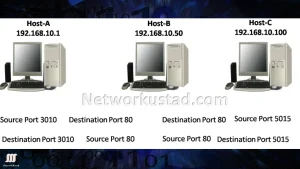The source host uses Address Resolution Protocol (ARP) to determine the destination MAC address. Although the destination MAC address can be a unicast, broadcast, or multicast, the source MAC address must always be unicast. Every device with an IP address on a network also has an Ethernet MAC address. When a device sends an Ethernet frame, it contains the destination MAC address and Source MAC address. To resolve the destination MAC address, Address Resolution Protocol (ARP) provides two essential functions:
- Resolving IPv4 addresses to MAC addresses
- Maintain a table of mappings
Address Resolution Protocol Functions
Resolving IPv4 Addresses to MAC Addresses
The data link layer encapsulates the incoming packet into an Ethernet frame. The encapsulation process refers to an Address Resolution Protocol (ARP) table in its memory to find the MAC address mapped to the IPv4 address. The Address Resolution Protocol (ARP) table is called the Address Resolution Protocol (ARP) cache. The Address Resolution Protocol (ARP) table is stored in the RAM. Each sending device searches its Address Resolution Protocol (ARP) table for a destination IPv4 address and a related MAC address.
- If the destination IPv4 address is on the same network as the source IPv4 address, the device will look at the ARP table for the destination IPv4 address.
- If the destination IPv4 address is not on the same network as the source IPv4 address, the device will look at the ARP table for the default gateway’s IPv4 address.
Each Address Resolution Protocol (ARP) table entry binds a MAC address with an IPv4 address. The relationship between IPv4 and MAC addresses is called a map. A map helps us find an IPv4 address in the table and the corresponding MAC address.
The Address Resolution Protocol (ARP) table saves the mapping temporarily. If the device receives a frame and finds no entry for the corresponding MAC address, then the device sends an ARP request. The ARP request messages are encapsulated directly within an Ethernet frame. There is no IPv4 header. The ARP request message includes the following:-
- Target IPv4 address –The IPv4 address of the destination device.
- Target MAC address – Unknown MAC address will be empty in the ARP request message.
The ARP request is encapsulated in an Ethernet frame with the following header information:
Destination MAC address – This broadcast address requires all Ethernet NICs on the LAN to accept and process the ARP request.
Source MAC address – This is the MAC address of the ARP request sender.
Type – ARP messages have a type field of 0x806. This informs the receiving NIC that the data portion of the frame needs to be passed to the ARP process.
ARP requests are broadcast processes, so the switch floods all ports except the receiving port with them. The device on the LAN whose IPv4 address matches the target IPv4 address in the ARP request will reply. All other devices will discard the ARP request packet. The figure below illustrates the ARP request.
If the destination IPv4 address is not on the same network as the source IPv4 address, the source device must send the frame to its default gateway, the router’s interface. The device will encapsulate that packet in a frame using the destination MAC address of the local router.
The default gateway IPv4 address is stored in the host’s IPv4 configuration. When a host creates a packet for a destination, it compares the destination IPv4 address and its own IPv4 address to determine if the two IP addresses are located on the same network. If the destination host is not on its same network, the source checks its ARP table for an entry with the default gateway’s IPv4 address. If there is no entry, it uses the ARP process to determine the MAC address of the default gateway.
Removing Entries from an ARP Table
The ARP cache saves the entries for a specified time, depending on the device’s operating system. We can also use the command to manually remove all or some of the entries in the ARP table. After removing an entry, sending an ARP request and receiving an ARP reply must occur again to enter the map in the ARP table.
ARP Tables
- The show ip arp in command displays the ARP table on a Cisco router.
- On Windows, the arp –a command displays the ARP table.
FAQs
What is the Address Resolution Protocol (ARP) and why is it important?
The Address Resolution Protocol (ARP) is a communication protocol used to map IP addresses to physical MAC addresses within a local network. It is important because it ensures that data is delivered to the correct device on a network.
How does ARP work in network communication?
ARP works by sending a broadcast request to all devices on the local network, asking for the MAC address associated with a specific IP address. The device with the matching IP address responds with its MAC address, allowing the sender to map the IP address to the correct physical address.
What is the structure of an ARP packet?
An ARP packet consists of fields such as the hardware type, protocol type, hardware address length, protocol address length, operation code (request or reply), sender hardware address, sender protocol address, target hardware address, and target protocol address.
Why is ARP used only within a local network?
ARP is used only within a local network because it relies on broadcast messages, which are not routed beyond the local network segment. This ensures that ARP requests and responses are confined to the local network.
How does ARP contribute to efficient data transmission?
ARP contributes to efficient data transmission by ensuring that IP packets are delivered to the correct physical devices on the network. By mapping IP addresses to MAC addresses, ARP enables accurate and reliable data delivery.






